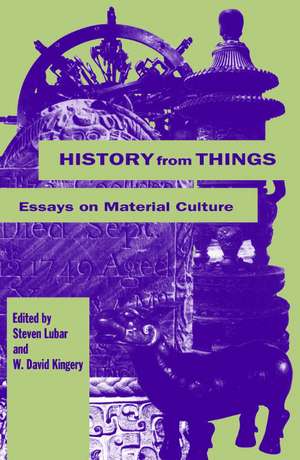History from Things: History from Things
Autor S. Lubar, Lubar Steven, David Kingery Wen Limba Engleză Paperback – 31 aug 1995
Spanning vast time periods, geographical locations, and academic disciplines, History from Things leaps the boundaries between fields that use material evidence to understand the past. The book expands and redirects the study of material culture—an emerging field now building a common base of theory and a shared intellectual agenda.
Preț: 152.67 lei
Nou
Puncte Express: 229
Preț estimativ în valută:
29.21€ • 30.14$ • 24.38£
29.21€ • 30.14$ • 24.38£
Carte indisponibilă temporar
Doresc să fiu notificat când acest titlu va fi disponibil:
Se trimite...
Preluare comenzi: 021 569.72.76
Specificații
ISBN-13: 9781560986133
ISBN-10: 1560986131
Pagini: 320
Dimensiuni: 153 x 228 x 19 mm
Greutate: 0.41 kg
Ediția:Revised
Editura: Smithsonian Books
ISBN-10: 1560986131
Pagini: 320
Dimensiuni: 153 x 228 x 19 mm
Greutate: 0.41 kg
Ediția:Revised
Editura: Smithsonian Books
Notă biografică
Steven Lubar is curator of engineering and industry at the Smithsonian Institution's National Museum of American History.
W. David Kingery is Regents Professor of Anthropology and Materials Science and Engineering at the University of Arizona.
W. David Kingery is Regents Professor of Anthropology and Materials Science and Engineering at the University of Arizona.
Recenzii
“Readers should find in History from Things much to provoke thinking about material culture and a stimulus to the type of interdisciplinary communication that the field of material culture studies has tried to offer.”—Journal of American History
“History from Things reminds us of the intellectual power of artifact analysis. . . . [It] is a useful book for beginning and experienced teachers of social studies, at every grade level, on the ways to use material culture to better understand the past and as routes to reflect on the more abstract features of culture.”—Social Education
“Eighteen essays discuss the use of artifacts and material culture evidence in broadening historical understanding of the past. Contributors come from a wide array of backgrounds, including art history, anthropology, archaeology, and the history of technology, and the artifacts examined range from Chinese bronzes to the cultural landscape of eighteenth-century English gardens and from New England cemeteries to a twentiety-century steam locomotive. Individually these essays push out the boundaries of material culture study, while collectively they transcend traditional disciplinary boundaries.”—Science, Technology, and Society
“History from Things reminds us of the intellectual power of artifact analysis. . . . [It] is a useful book for beginning and experienced teachers of social studies, at every grade level, on the ways to use material culture to better understand the past and as routes to reflect on the more abstract features of culture.”—Social Education
“Eighteen essays discuss the use of artifacts and material culture evidence in broadening historical understanding of the past. Contributors come from a wide array of backgrounds, including art history, anthropology, archaeology, and the history of technology, and the artifacts examined range from Chinese bronzes to the cultural landscape of eighteenth-century English gardens and from New England cemeteries to a twentiety-century steam locomotive. Individually these essays push out the boundaries of material culture study, while collectively they transcend traditional disciplinary boundaries.”—Science, Technology, and Society
